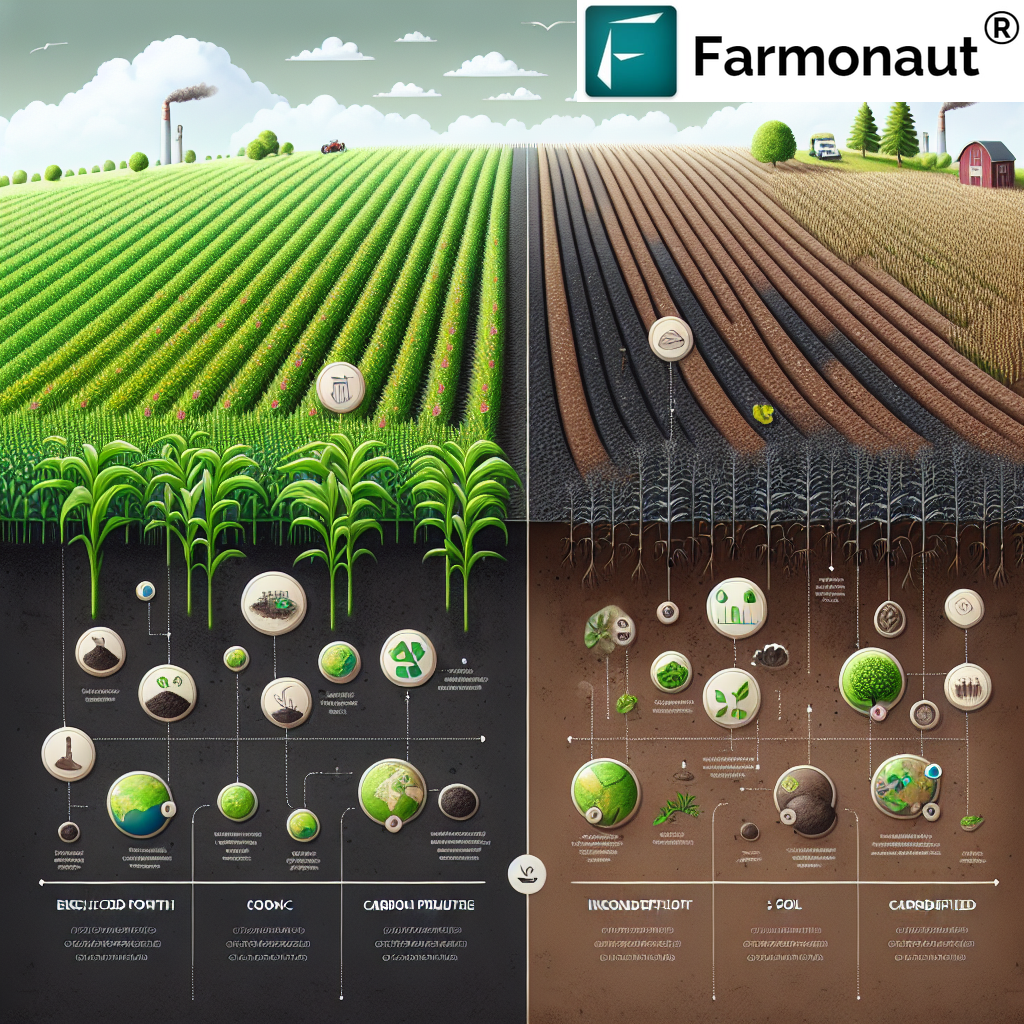
Unlocking Soil Health: Understanding Carbon in Soil and Its Impact on Agriculture
At Farmonaut, we’re passionate about empowering farmers with cutting-edge technology and knowledge to optimize their agricultural practices. Today, we’re diving deep into a crucial aspect of soil health that plays a vital role in sustainable farming: carbon in soil. In this comprehensive guide, we’ll explore the importance of soil carbon, its impact on agriculture, and how modern farming techniques can help manage and improve soil carbon levels.
Table of Contents
- What is Soil Carbon?
- The Importance of Carbon in Soil
- Sources of Soil Carbon
- Carbon Cycle in Soil
- Factors Affecting Soil Carbon Levels
- Benefits of Optimal Soil Carbon Levels
- Challenges of Too Much Carbon in Soil
- Measuring and Monitoring Soil Carbon
- Strategies for Managing Soil Carbon
- The Role of Technology in Soil Carbon Management
- Farmonaut’s Approach to Soil Health Monitoring
- FAQs About Carbon in Soil
1. What is Soil Carbon?
Soil carbon refers to the carbon stored in soil organic matter and is a crucial component of soil health. It’s a key indicator of soil quality and plays a vital role in various soil functions. But what exactly is soil carbon, and why is it so important?
Soil carbon is primarily found in two forms:
- Organic carbon: Derived from living organisms and their decomposition products
- Inorganic carbon: Primarily in the form of carbonate minerals
When we talk about carbon in the soil, we’re often referring to organic carbon, which is the focus of most agricultural and environmental discussions.
2. The Importance of Carbon in Soil
Carbon in soil is not just a passive component; it’s a dynamic element that influences numerous soil properties and processes. Here’s why carbon soil interactions are so crucial:
- Soil Structure: Carbon helps bind soil particles, improving soil structure and stability
- Water Retention: Soil with higher carbon content can hold more water, reducing runoff and erosion
- Nutrient Cycling: Carbon is essential for nutrient cycling and availability to plants
- Microbial Activity: It supports a diverse and active soil microbial community
- Climate Regulation: Soil acts as a significant carbon sink, helping mitigate climate change
3. Sources of Soil Carbon
Understanding where soil carbon comes from is crucial for managing it effectively. The primary sources of carbon for soil include:
- Plant Residues: Leaves, roots, and other plant materials that decompose in the soil
- Root Exudates: Organic compounds released by plant roots
- Microbial Biomass: Carbon contained in soil microorganisms
- Manure and Compost: Organic materials added to soil as amendments
- Atmospheric CO2: Fixed by plants through photosynthesis and eventually incorporated into the soil
4. Carbon Cycle in Soil
The carbon cycle in soil is a complex process involving various transformations and exchanges. Here’s a simplified overview:
- Carbon Inputs: Plants capture CO2 from the atmosphere through photosynthesis
- Carbon Allocation: Some carbon is used for plant growth, while some is transferred to the soil via roots and plant residues
- Decomposition: Soil organisms break down organic matter, releasing some carbon as CO2 and incorporating some into their biomass
- Stabilization: Some carbon becomes stabilized in soil aggregates or bound to minerals
- Carbon Loss: Carbon can be lost from soil through erosion, leaching, or as CO2 emissions
5. Factors Affecting Soil Carbon Levels
Several factors influence the amount of carbon in the soil:
- Climate: Temperature and precipitation affect carbon inputs and decomposition rates
- Soil Type: Clay soils tend to store more carbon than sandy soils
- Land Use: Agricultural practices, forestry, and urbanization impact soil carbon levels
- Vegetation: Different plant types contribute varying amounts of carbon to the soil
- Management Practices: Tillage, crop rotation, and fertilization influence soil carbon dynamics
6. Benefits of Optimal Soil Carbon Levels
Maintaining optimal levels of carbon in soil offers numerous benefits for agriculture and the environment:
- Improved Soil Fertility: Higher carbon levels enhance nutrient availability and retention
- Better Water Management: Increased water holding capacity and improved drainage
- Enhanced Crop Yield: Healthier soils support higher and more stable crop yields
- Increased Biodiversity: Carbon-rich soils support a diverse range of soil organisms
- Climate Change Mitigation: Soils with high carbon content help sequester atmospheric CO2
7. Challenges of Too Much Carbon in Soil
While carbon is generally beneficial for soil health, there can be challenges associated with too much carbon in soil:
- Nutrient Imbalances: Excessive carbon can lead to nitrogen immobilization
- Altered pH: High organic matter content can influence soil acidity
- Waterlogging: In some cases, very high carbon content can lead to poor drainage
- Increased Greenhouse Gas Emissions: Under certain conditions, high carbon soils may emit more methane
It’s important to note that these issues are relatively rare and usually occur under specific circumstances. In most agricultural contexts, increasing soil carbon is a positive goal.
8. Measuring and Monitoring Soil Carbon
Accurate measurement of soil carbon is crucial for effective management. Here are some methods used to measure what is carbon in soil:
- Dry Combustion: The most accurate method, involving heating soil samples to high temperatures
- Loss on Ignition: A simpler method that estimates organic matter content
- Spectroscopic Methods: Near-infrared and mid-infrared spectroscopy for rapid analysis
- Remote Sensing: Satellite and drone-based methods for large-scale assessments
At Farmonaut, we leverage advanced satellite technology to provide insights into soil health, including indicators related to organic matter content. Our satellite-based crop health monitoring system offers a cost-effective way to track soil health trends over time.
9. Strategies for Managing Soil Carbon
Effective management of soil carbon is key to sustainable agriculture. Here are some strategies farmers can employ:
- Conservation Tillage: Reducing soil disturbance helps preserve soil carbon
- Cover Cropping: Planting cover crops adds organic matter to the soil
- Crop Rotation: Diversifying crops can enhance carbon inputs and soil health
- Organic Amendments: Adding compost or manure increases soil carbon content
- Agroforestry: Integrating trees into agricultural landscapes can boost carbon sequestration
- Precision Agriculture: Using technology to optimize resource use and minimize soil disturbance
10. The Role of Technology in Soil Carbon Management
Modern technology plays a crucial role in managing soil carbon effectively. Here’s how:
- Remote Sensing: Satellite and drone imagery can provide insights into soil organic matter content
- Precision Agriculture Tools: GPS-guided equipment helps minimize soil disturbance
- Data Analytics: Advanced algorithms can predict soil carbon trends and optimize management practices
- IoT Sensors: In-field sensors can provide real-time data on soil conditions
- Blockchain: Enables carbon credit systems for farmers sequestering carbon
11. Farmonaut’s Approach to Soil Health Monitoring
At Farmonaut, we’re committed to providing farmers with cutting-edge tools for soil health management, including carbon monitoring. Our satellite-based system offers several advantages over traditional methods:
| Feature | Farmonaut Satellite System | Drone-based Monitoring | IoT-based Monitoring |
|---|---|---|---|
| Coverage Area | Large scale (entire farms) | Limited by flight time | Limited to sensor placement |
| Frequency of Data | Regular updates (3-5 days) | Depends on flight schedule | Continuous but localized |
| Cost-effectiveness | High | Medium | Low for large areas |
| Ease of Use | No on-farm equipment needed | Requires skilled operator | Requires installation and maintenance |
| Data Integration | Seamless with Farmonaut platform | May require additional processing | Often platform-specific |
Our system provides valuable insights into soil health indicators, helping farmers make informed decisions about carbon management practices. To learn more about our services, visit our app or explore our API documentation.
12. FAQs About Carbon in Soil
Q: Is carbon found in soil naturally?
A: Yes, carbon is naturally found in soil. It’s a fundamental component of soil organic matter and plays a crucial role in soil health and fertility.
Q: What is soil carbon, and why is it important?
A: Soil carbon refers to the carbon stored in soil, primarily in organic matter. It’s important because it improves soil structure, water retention, nutrient cycling, and supports biodiversity. It also plays a role in climate change mitigation by sequestering atmospheric CO2.
Q: Can there be too much carbon in soil?
A: While it’s rare, there can be challenges associated with very high levels of carbon in soil, such as nutrient imbalances or altered pH. However, in most agricultural contexts, increasing soil carbon is beneficial.
Q: How can farmers increase carbon in their soil?
A: Farmers can increase soil carbon through practices like conservation tillage, cover cropping, crop rotation, adding organic amendments, and implementing agroforestry systems.
Q: How does Farmonaut help with soil carbon management?
A: Farmonaut provides satellite-based monitoring of crop and soil health indicators, offering insights that can help farmers make informed decisions about carbon management practices. Our technology allows for large-scale, cost-effective monitoring of soil health trends over time.
Conclusion
Understanding and managing carbon in soil is crucial for sustainable agriculture and environmental stewardship. As we’ve explored, soil carbon plays a vital role in soil health, crop productivity, and even climate change mitigation. By leveraging modern agricultural practices and technologies like those offered by Farmonaut, farmers can effectively monitor and manage their soil carbon levels, leading to healthier soils, better crops, and a more sustainable future.
Ready to take your soil management to the next level? Explore Farmonaut’s solutions:
Subscribe to Farmonaut’s services and start optimizing your soil health today:
